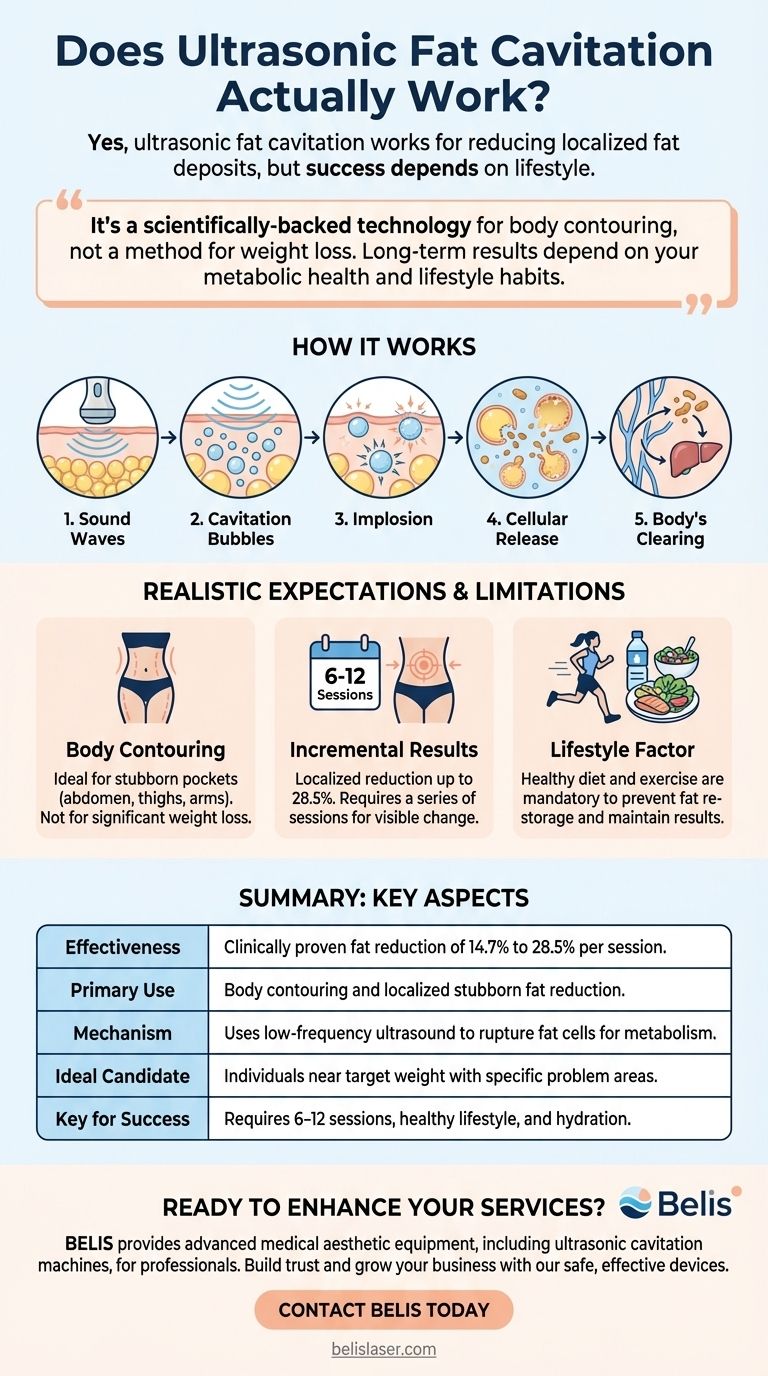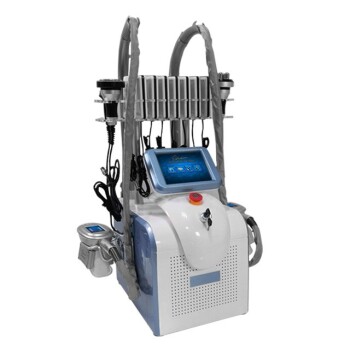Yes, ultrasonic fat cavitation works for reducing localized fat deposits. Clinical studies confirm its effectiveness, showing that a single session can reduce fat cells in the treated area by a measurable margin, with some studies citing a reduction of 14.7% to 28.5%. However, its success is not guaranteed and is highly dependent on the individual, the treatment area, and post-procedure lifestyle choices.
Ultrasonic cavitation is a scientifically-backed technology for body contouring, not a method for weight loss. It physically destroys fat cells in a targeted area, but the body's long-term response and the visibility of results are entirely dependent on your metabolic health and lifestyle habits.

How Ultrasonic Cavitation Works
To understand if this procedure is right for you, it's crucial to understand the biological mechanism. The process is more than just "melting fat"; it's a targeted cellular disruption.
The Role of Low-Frequency Sound Waves
The procedure uses a handheld device that emits powerful, low-frequency ultrasonic waves. These waves are directed into the skin and penetrate the subcutaneous layers where fat is stored.
Creating 'Cavitation' Bubbles
The sound waves create a series of rapid pressure changes within the interstitial fluid surrounding the fat cells. This pressure variation leads to the formation of microscopic bubbles or "cavities"—a phenomenon known as cavitation.
The Implosion Effect on Fat Cells
As the ultrasonic field continues, these micro-bubbles grow until they become unstable and implode. This collapse creates a powerful shockwave that is localized to the microscopic area.
Releasing the Cellular Content
The energy from this implosion is strong enough to rupture the membranes of nearby adipocytes (fat cells) without harming other tissues like skin or nerves. The fat cell's contents—primarily triglycerides—are released into the interstitial space.
Your Body's Clearing Process
This is the most critical step. The released triglycerides are transported by the lymphatic system to the liver. The liver then metabolizes them, treating them just like fat from the food you eat. They are either used for energy or excreted from the body.
Setting Realistic Expectations
The term "works" is subjective. For ultrasonic cavitation, success must be defined as targeted body contouring, not as a solution for general weight loss.
It’s for Body Contouring, Not Weight Loss
This procedure is designed to sculpt and reduce stubborn pockets of fat that are resistant to diet and exercise. It is ideal for the abdomen, thighs, "love handles," or upper arms. It will not cause a significant drop on the scale.
Results Are Localized and Incremental
The fat reduction—up to 28.5% in some cases—occurs only in the area being treated. To see visible results, most individuals require a series of 6 to 12 sessions, typically spaced a week apart to allow the body time to process the released fat.
Your Lifestyle Is the Deciding Factor
If you do not create an energy deficit through diet and exercise, the fat released into your system can simply be re-stored in other remaining fat cells. A healthy lifestyle is not optional for maintaining results; it is a mandatory part of the treatment protocol.
Understanding the Trade-offs and Limitations
Like any cosmetic procedure, ultrasonic cavitation is not a perfect solution and comes with important considerations. Being aware of them is key to avoiding disappointment.
Results Are Not Permanent on Their Own
The procedure permanently destroys fat cells in the treated area. However, the remaining fat cells in your body can still expand if you gain weight. The contoured shape can be lost without consistent lifestyle management.
Effectiveness Varies Greatly
Results differ based on your individual physiology, the density and type of fat being treated, your hydration levels (water is essential for the process), and your body's metabolic efficiency. Not everyone will see the same level of reduction.
Not Everyone Is a Good Candidate
The ideal candidate is someone who is already close to their target weight but struggles with specific problem areas. The procedure is not recommended for individuals with obesity, liver or kidney disease, pacemakers, or those who are pregnant or breastfeeding.
The Practitioner’s Skill Is Paramount
The safety and effectiveness of the treatment depend heavily on the skill of the operator and the quality of the machine. An inexperienced technician can produce poor results or, in rare cases, cause skin irritation.
Making the Right Choice for Your Goal
To decide if ultrasonic cavitation is right for you, align the procedure's capabilities with your primary objective.
- If your primary focus is significant weight loss: This procedure is not your solution. Prioritize a comprehensive plan involving diet, exercise, and consultation with a healthcare professional.
- If your primary focus is targeting stubborn fat pockets: Ultrasonic cavitation can be a highly effective, non-invasive tool for achieving a more sculpted physique in specific areas.
- If your primary focus is a quick, one-time fix: Approach with caution. Lasting results require multiple sessions and a long-term commitment to a healthy lifestyle to prevent the fat from returning.
Viewing ultrasonic cavitation as a powerful supplement to a healthy lifestyle, rather than a substitute for it, is the key to achieving satisfactory and lasting results.
Summary Table:
| Key Aspect | Details |
|---|---|
| Effectiveness | Clinically proven to reduce fat cells in targeted areas by 14.7% to 28.5% per session. |
| Primary Use | Body contouring and reducing localized, stubborn fat deposits (e.g., abdomen, thighs). |
| Mechanism | Uses low-frequency ultrasound waves to rupture fat cell membranes, releasing contents for the body to metabolize. |
| Ideal Candidate | Individuals near their target weight with specific problem areas resistant to diet and exercise. |
| Key for Success | Requires a series of sessions (6-12) and a commitment to a healthy lifestyle and hydration for lasting results. |
Ready to enhance your body contouring services with professional-grade technology?
BELIS specializes in providing advanced medical aesthetic equipment, including ultrasonic cavitation machines, to medical aesthetics clinics and premium beauty salons. Our professional-grade devices ensure safe, effective, and consistent results for your clients, helping you build trust and grow your business.
Contact BELIS today to explore our range of reliable aesthetic equipment and learn how we can support your clinic's success.
Visual Guide

Related Products
- Ultrasonic Cavitation Radiofrecuency Machine for Body Slimming
- Cryolipolysis Fat Freezing Machine and Ultrasonic Cavitation Device
- 7D 12D 4D HIFU Machine Device
- Cryolipolysis Fat Freezing Machine Ultrasonic Cavitation Fat Reducing Device
- EMSlim RG Laser Body Sculpting and Slimming Machine
People Also Ask
- Does ultrasound really break down fat? Discover the Science of Non-Invasive Fat Reduction
- What are the restrictions for cavitation? Ensure Your Safety and Treatment Success
- How many RF sessions do you need to see results? Achieve firmer, tighter skin with a personalized plan.
- What does a cavitation machine do for your body? Sculpt Your Contours Without Surgery
- When should you not use a cavitation machine? Critical Safety Guidelines for Aesthetic Treatments



















